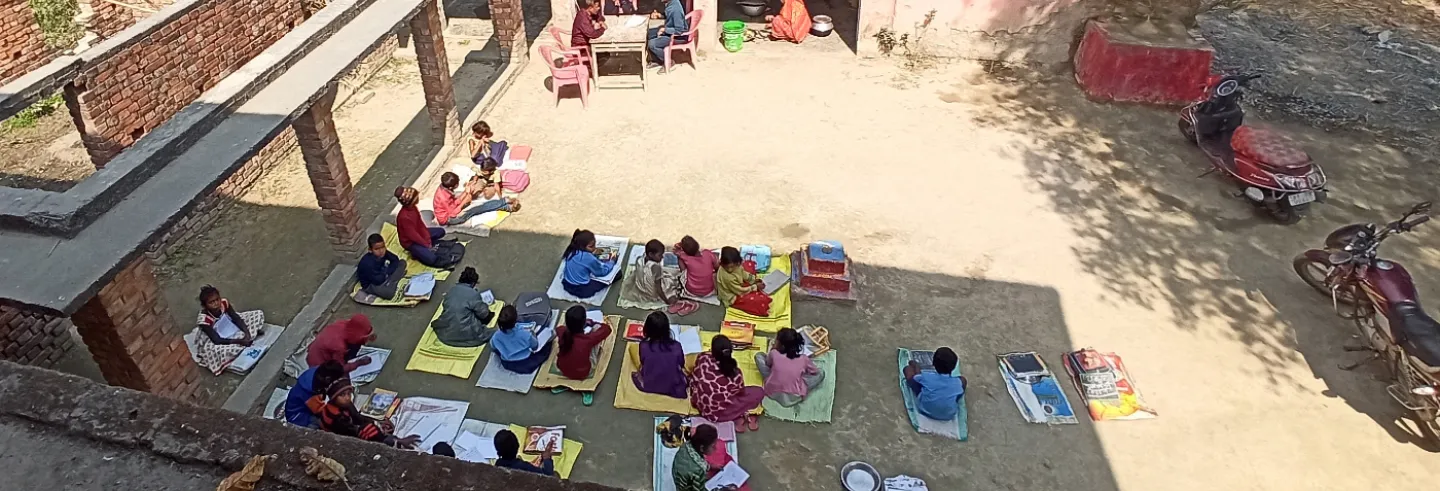Few things are more important for a society than its children’s education. Evidence shows that children’s primary education has immediate and long-term effects on both individual and collective well-being (Psacharopoulos and Patrinos 2002). It is one of the most agreed upon means of development. Yet Bihar, one of India’s poorest states, is turning its back on school education. Such is the dismal conclusion of a recent survey of government schools in north Bihar.
The survey, conducted by the Jan Jagran Shakti Sangathan (JJSS) in August 2023, Jan Jagran Shakti Sangathan is a registered trade union of unorganised sector workers that aims to empower the rural poor to demand better services and claim their entitlements. The organisation works in the Seemanachal area of North Bihar, with Araria and Katihar districts as its strongholds. For the full survey report, see roadscholarz.net/reports/.
The survey covered 81 primary and upper primary schools in Araria and Katihar districts of Bihar (JJSS 2023). The sample schools were spread across 11 blocks in these two districts and were randomly selected from among those that had at least 50% Dalit, Adivasi, minority, or other backward class (OBC) students. The survey found that most schools struggle to meet bare minimum standards, as illustrated by the report card on primary schools.
In this article, we discuss two interdependent causes that plague the education system in Bihar—inadequate resources and ineffective policies. We also compare the findings with those of a similar survey conducted in Jharkhand and discuss their implications.
Inadequate Resources
Funding for government schools comes from the centre and the state in a 60:40 ratio under the Samagra Shiksha Abhiyaan (SSA). In recent years, there has been a decelerating trend in the centre’s share in Bihar (Bose and Sharma 2023). The large financial gap between the needed spending and the actual spending has a very adverse effect on low resource base states such as Bihar.
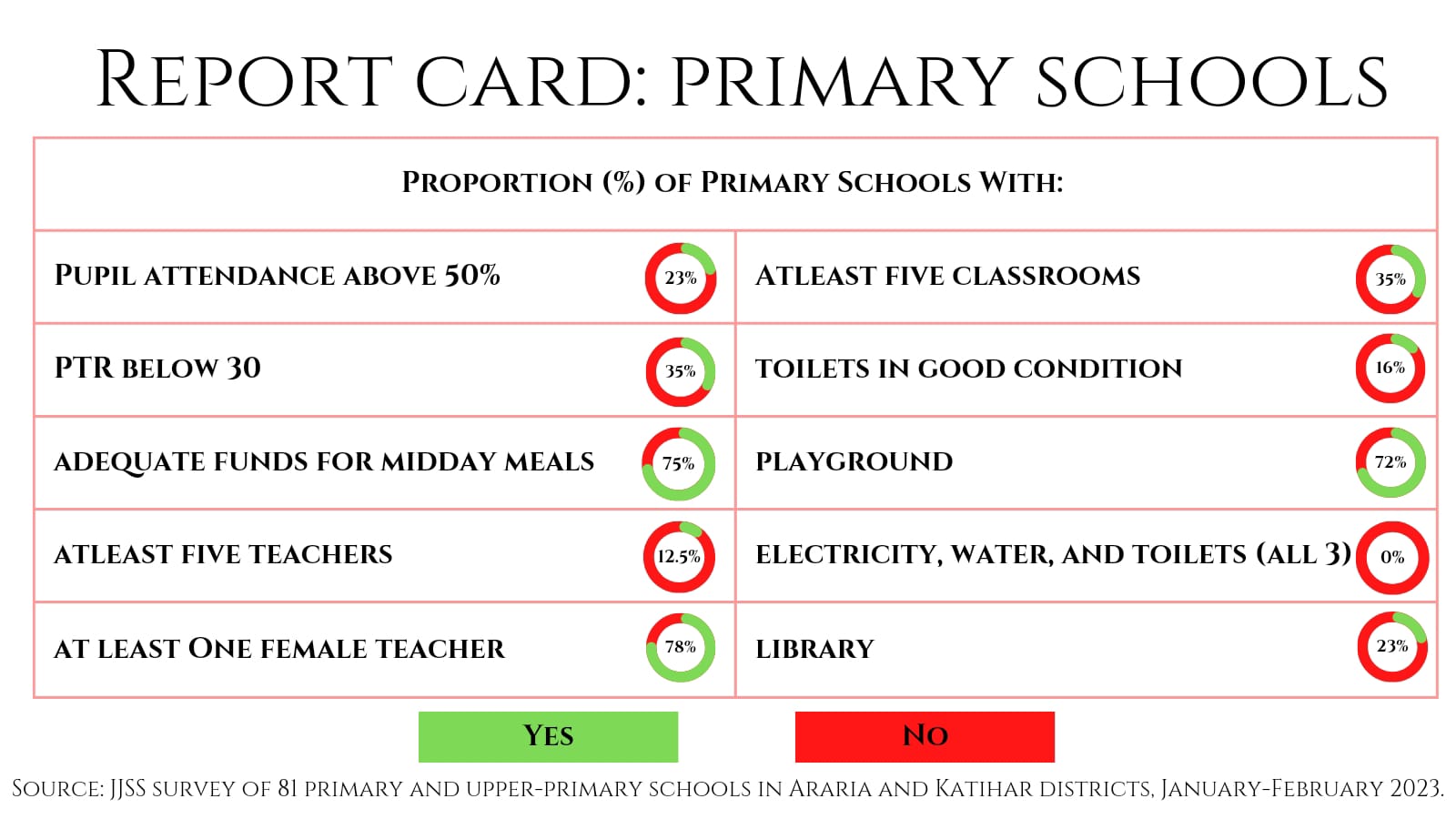
A direct impact of this can be seen in the severe shortage of teachers in government schools. Of the sample schools, 79% failed to meet the norm prescribed in the Right to Education (RTE) Act of at least one teacher for every 30 pupils at the primary level. In addition, Bihar’s classification of teachers into three groups, based on pay, nature of contract, and selection criteria, create a pecking order and discord amongst the workforce. As one of them said, “Classification of teachers, with different types given different salaries, should end. Teachers are needed based on their subject matter expertise.”
The shortage of funds is reflected in the absence of basic infrastructure. The JJSS survey found that most schools have cramped classrooms, with very few tables and chairs. Washrooms were largely dysfunctional, and there was no water supply. Boundary walls were a rarity. The school management committee fund meant to maintain the premises was insufficient.
The JJSS survey found many students in schools had no textbooks or uniforms. There were various reasons for this, but the main one was families were using the money for other necessities.
In some cases, primary schools were running in temporary shelters made of bamboo and straw. In one primary school, which had 150 students on its rolls and one classroom, teaching was impossible. The investigators observed, “The infrastructure of the school was very bad. The classroom was made of bamboo and mud and quite damaged. The roof was of tin. It is difficult to imagine any type of teaching happening in the school. Two newly installed hand pumps did not work. A cow was grazing in the school premises. There is no proper road to the school.”
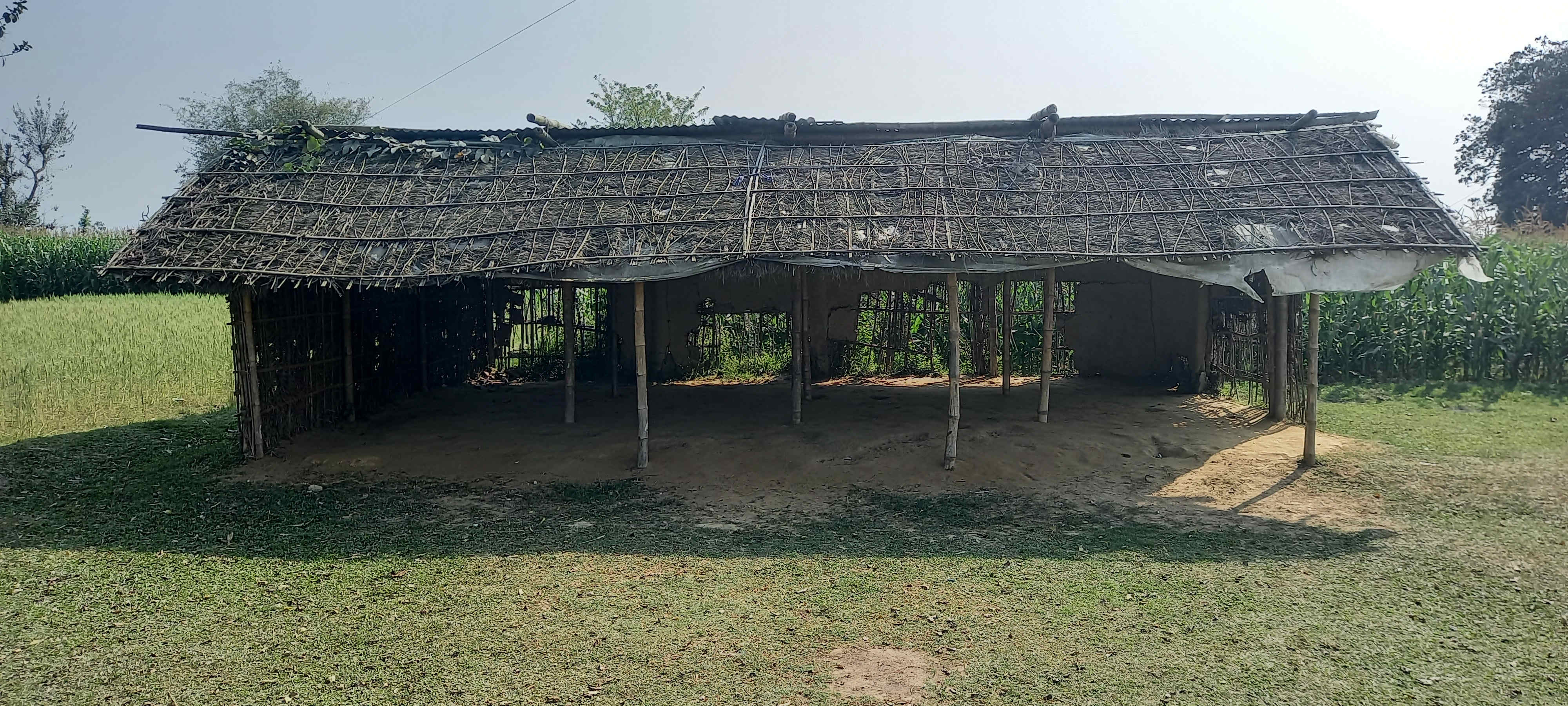
If that was not enough, 9% of the sample schools had no building of their own. They functioned from vacant government offices or in neighbouring schools. Of all government schools in Bihar, 7% had no building, and 120 of them were in Patna district (Mishra 2023).
Ineffective Policies
Bihar’s education system follows several policies that are ineffective and may even be doing more harm than good. One of them is the direct benefit transfer system for distributing textbooks and uniforms. Under this, money is sent to the bank accounts of children (or their parents), and they are expected to buy textbooks and uniforms on their own.
The JJSS survey found many students in schools had no textbooks or uniforms. There were various reasons for this, but the main one was families were using the money for other necessities. The failure to ensure every student has books and uniforms has serious consequences. In a schooling system focused on textbooks, it is very difficult to learn without them, and uniforms possibly help mitigate signs of inequality among students.
Thankfully, the direct benefit transfer system for textbooks has been withdrawn this year, but it continues for uniforms. Incidentally, most teachers are opposed to the direct benefit transfer system. As one of them put it, “Distribution of textbooks should be done by the government in a timely manner. Direct benefit transfer for textbooks does not help as many parents spend the money on other expenses.”
Another example of misguided policies relates to school attendance records. Teachers in Bihar routinely over-report student attendance. The main reason, it seems, is that the local administration sends them show-cause notices if there are large shortfalls in student attendance on consecutive days. This fear-based policy drives teachers to inflate attendance figures in the registers.
Field notes from a middle school elucidate this problem:
“The number of students present was hugely over-reported. The teacher explained that sometimes due to festivals the attendance of students drops sharply for a few days. If they report the actual numbers, they get a show-cause notice from their superiors and they must bribe people to get the problem sorted. So they gradually decrease the number of students instead of reporting the actual numbers.”
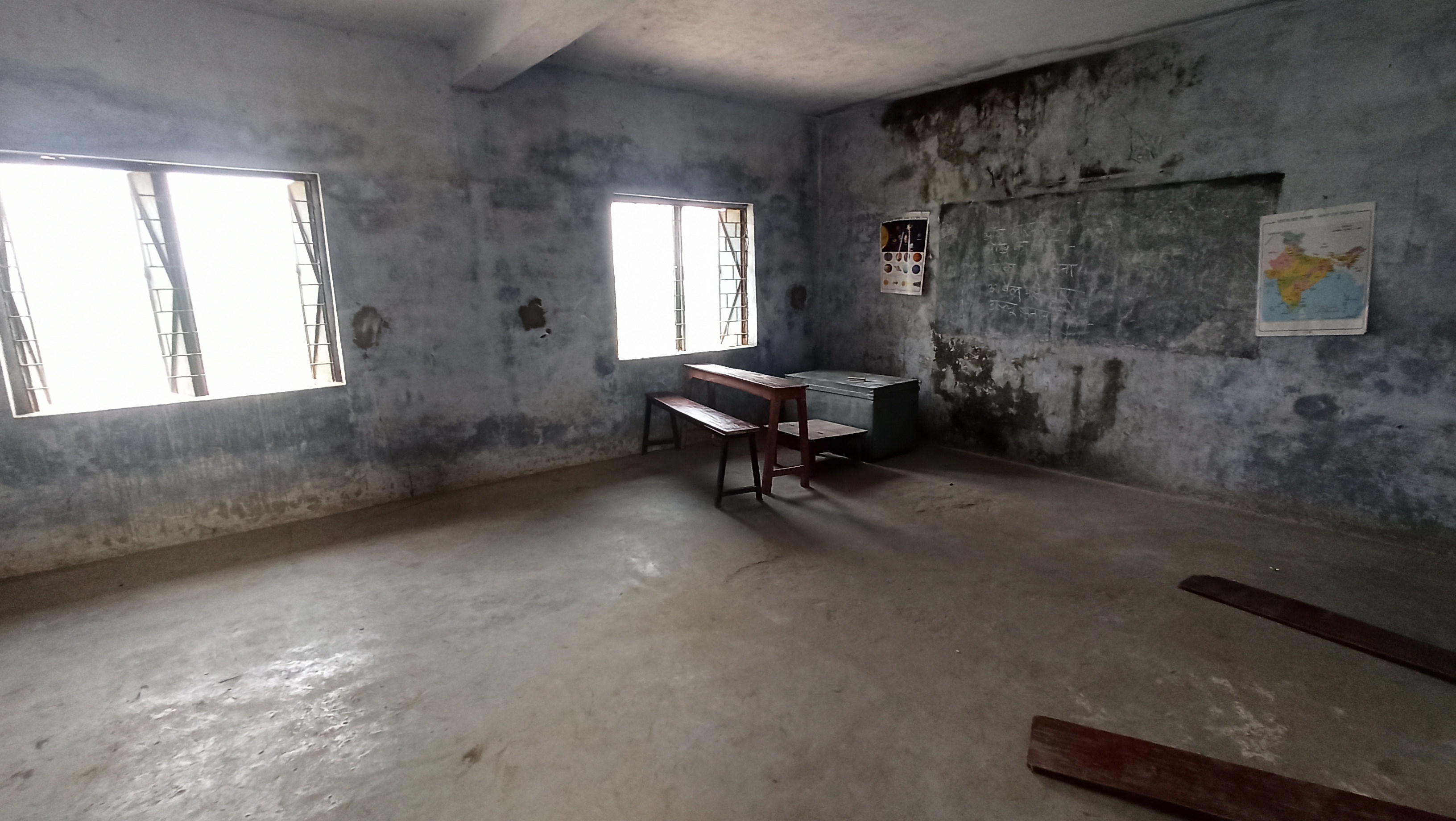
According to teachers, over-reporting of attendance also has something to do with the cost of eggs, which are a part of the midday meal. The government’s costing norms underestimate the market price of eggs, and teachers make up for this by over-reporting attendance. On an average, we found that the number of students present according to the attendance registers was about twice the number present at the time the investigators visited.
Teachers in Bihar routinely over-report student attendance. The main reason, it seems, is that the local administration sends them show-cause notices if there are large shortfalls in student attendance on consecutive days.
Another massive policy failure relates to the Covid-19 crisis. The Covid-19 lockdown brought all physical classes to a halt. While better-off children were able to fall back on online learning, most students enrolled in government schools had nothing of the kind. In most of the sample schools, teachers reported that many students in grades 3 to 5 had forgotten to read and write by the time they came back to school.
Despite this, no significant remedial measures were initiated in the following academic session. Extra classes were not held and school timings were not extended. The only innovation was the distribution of Foundational Literacy and Numeracy (FLN) textbooks, promoted by the central government. The survey found no clear sign of their helpfulness to students or teachers. The only positive was that in the absence of regular textbooks, these books were better than nothing.
Where Are the Children?
Government schools in Bihar are on the verge of dysfunction. The clearest indication of this is student attendance. Average attendance rates, based on a direct count, were just 20% in primary schools and 23% in upper primary schools. Even the inflated figures reported in registers were low—40% for primary schools and 44% for upper primary schools.
There is an urgent need to understand why school attendance figures are so low in Bihar. Low teaching standards and inactivity in the classroom may discourage students from attending regularly. Teachers reported their inability to retain students after the midday meal. Prolonged school closures during the Covid-19 pandemic have affected children’s school-going habits and created an impression that it is not important to go to school. This exodus has been reinforced by the denial of textbooks and uniforms under the direct benefit transfer system. The cumulative effect is that most students are not in school on most days.
Children’s absence from schools is associated with a growing reliance on modestly priced private tuition. Many parents and students depended on such tuition classes in the absence of functioning schools. It would be a mistake, however, to assume that most of the students who are absent from government schools make up for it by taking private tuitions.
Tuition centres mostly work as places of rote learning for examinations and do not provide a wholesome environment for growing children that functioning schools do.
According to National Sample Survey (NSS) data for 2017-2018, 29% of primary school students in Bihar attended private tuition classes.The corresponding figure at the upper-primary level is 42%. These figures were provided by former World Bank economist Sajitha Bashir, based on her analysis of NSS 2017-2018 data. The corresponding figure for students enrolled in government primary schools now would be 36%, bearing in mind that about 80% of children in Bihar attend government schools (ASER 2022). If attendance rates in government primary schools are just around 20%, as the JJSS survey says, these figures imply that a substantial proportion of children in Bihar are neither going to school regularly nor taking private tuitions, especially among disadvantaged families. They are simply not getting any formal education worth the name.
In any case, it remains unclear whether private tuitions, which are unregulated, are suitable for student learning. Tuition centres mostly work as places of rote learning for examinations and do not provide a wholesome environment for growing children that functioning schools do.
Bihar and Jharkhand
The schooling system in Jharkhand is also in a bad shape, but it is better than Bihar, judging from a similar survey conducted in Jharkhand in 2022 (Gyan Vigyan Samiti 2022). Jharkhand has higher student attendance rates, better compliance with RTE norms for pupil-teacher ratios, and somewhat better infrastructure. The midday meal in Jharkhand includes two eggs per child every week, compared with just one in Bihar. Problems such as missing textbooks and an overreliance on private tuition are not as bad as Bihar. Table 1 summarises the comparative situation that emerges from the JJSS and Gyan Vigyan Samiti surveys.
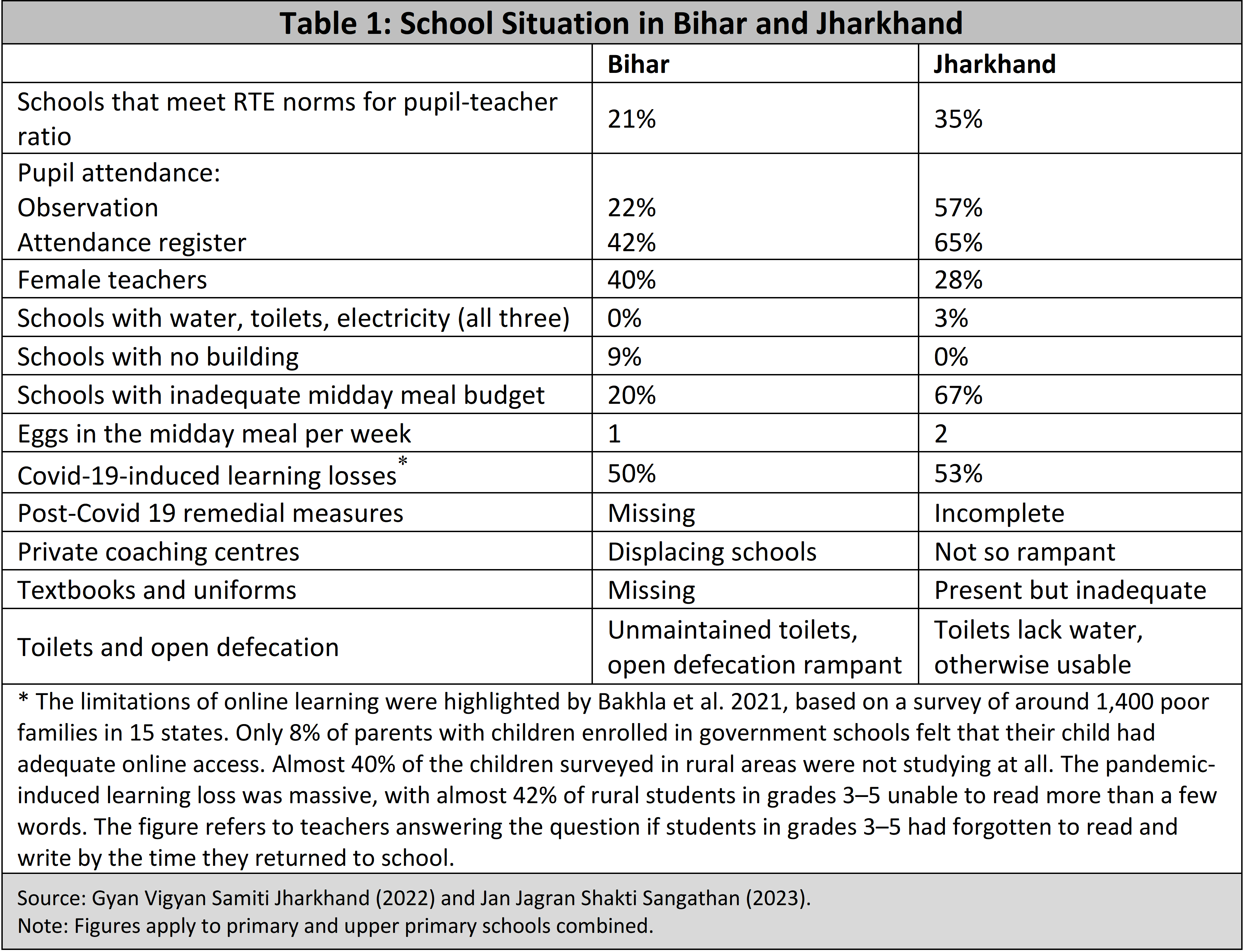
But there are some aspects in which Bihar takes the lead. There is a lower gender gap among teachers in Bihar, with more than 40% women teachers. Jharkhand has only 28%. Bihar also has a smaller proportion (about 10%) of single-teacher schools at the primary level. The figure for Jharkhand is a whopping 30%. On most counts, of course, the situation is quite grim in both states, but it can be said that, ever so slightly, primary and upper primary schools are doing better in Jharkhand than Bihar.
The Road Ahead
Yet, all is not lost for government schools. Indeed, as the Public Report on Basic Education (PROBE Team 1996) and the PROBE Revisited (De et al. 2006) illustrate, government schools have improved since the 1990s in many respects, including infrastructure, enrolment rates, and midday meals. Despite the progress, they still do not conform to the norms set by the RTE Act, 2009. The improvements in terms of facilities, infrastructure, and incentives have also not translated into higher classroom activity.
The Annual Status of Education Reports corroborate the sorry state of affairs in Bihar. ASER 2022 report showed that nearly 87% of grade 3 students, 63% of grade 5 students, and 30% of standard 8 students were unable to read a grade 2-level text. This shows that despite high enrolment rates and the appearance of near universal elementary education, a large proportion of children in Bihar do not obtain quality education in government schools and they also cannot afford private tuition.
A campaign on the Right to Education should be initiated. If communities know what they are entitled to, they may be more demanding and participate more actively in school management and monitoring.
Yet, this crisis is off the radar. There is hardly any public discussion about the status of government schools in Bihar (or Jharkhand, for that matter). The school monitoring system through block resource centres is also in disarray. It was only in July 2023 that retired teachers were hired as new block resource persons and weekly visits, however ceremonial, were restarted.
What could be the reason for this absence of public interest and lack of political will to improve government schools? Could it be that most of the children enrolled in these schools are children from Dalit, Adivasi, OBC, and other underprivileged families? The condition of government schools today reflects the discriminatory nature of schooling opportunities in India, where marginalised communities get the worst facilities.
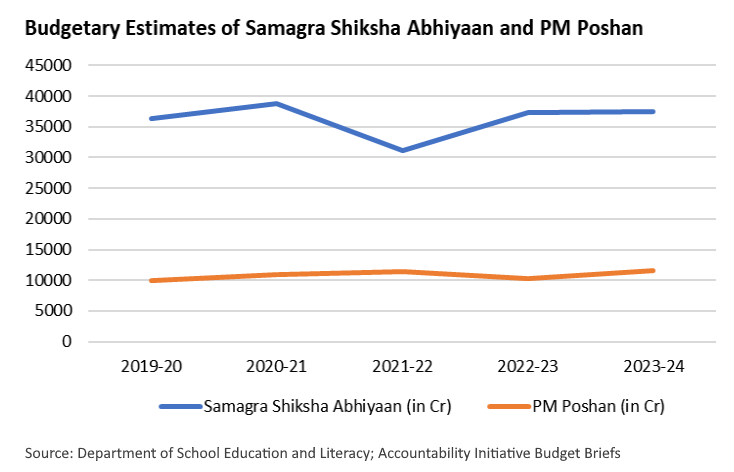
Many decades ago, the Kothari Commission suggested that India increase its education budget to 6% of the gross domestic product (GDP) and spend one third of it on elementary education. Even today, the country spends only 2.9% of its GDP on education, and 35% of it goes to elementary education (Sahay 2023). The financing gap is not new, but it has become worse in recent years.
As Figure 1 shows, both the SSA and PM-Poshan (midday meal) budgets have stagnated in the last five years. In real terms, they have declined steadily year after year. The states also need to contribute more. But, as a share of the state’s gross domestic product (GSDP), Bihar’s education budget is lower now than it was a decade or so ago (Bose and Sharma 2023). Today, Bihar has a quarter of the funds it needs to ensure it complies with RTE norms in all government schools.
Finally, a campaign on the right to education, with a special focus on underprivileged children, should be initiated. If communities know what they are entitled to from a government school, they may be more demanding and participate more actively in school management and monitoring. A much stronger grievance redressal system is also needed to ensure that people’s complaints are heard and addressed.
Ensuring that government schools work well is a matter of national importance. An urgent collective effort is needed to give children’s education the attention it so obviously deserves.
Paran Amitava is an independent researcher studying the schooling system in Jharkhand. Kanika Sharma is a Ph.D. candidate in the Department of Sociology at Emory University.
The authors are grateful to Jean Dreze for his comments on a previous version of this article.

